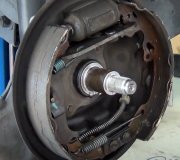If the pedal is still nice and firm, the pads might be glazed. You can sand the linings but the rotors are usually glazed too. The fastest way to solve that is by having the rotors machined again or by sanding them aggressively with course sandpaper. The roughness will wear off the glazing on the pads.
If the pedal is simply hard to push, you might have a booster problem. With the engine off, stroke the pedal at least three or four times to exhaust any stored vacuum. Next, hold the brake pedal down with normal force, then start the engine. As soon as the engine starts, the pedal should sink another couple of inches very easily. If it does not, check the large vacuum hose that goes from the engine to the booster for kinks or cracks. If the pedal does react properly, release it, stop the engine, wait about five to ten seconds, then press the pedal to see how easily it goes down. You should get at least two power-assisted presses of the pedal before the vacuum is gone. If the pedal pushes hard right after the engine is stopped, suspect a defective check valve inline with the vacuum hose going to the booster.
Tuesday, May 3rd, 2011 AT 6:41 AM



